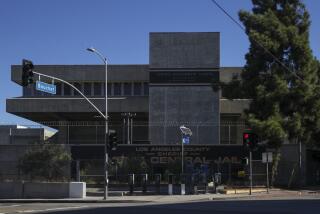Clink of Money Heard in Old London Jail : Tourism: Doors of the House of Detention, once known as Clerkenwell Bridewell, creak open as newest of several ‘crime attractions’ in the capital.
- Share via
LONDON — Businessman Leon Andrews-Zannetou believes he has just the place for foreign visitors seeking to trace the steps of their English ancestors.
It is damp, dim and underground. Water seeps through narrow brick ventilation tunnels filled with musty air and mournful voices.
The doors of the House of Detention, once known as Clerkenwell Bridewell, creaked open this month as the newest of several “crime attractions” in the capital.
Founded in 1616, and once described as a Victorian clearing-house for crime, the building in its heyday housed tens of thousands of prisoners awaiting trial.
Many convicts were subsequently deported to far-flung colonies such as Australia and New Zealand under the harsh penal laws in force until the mid 19th Century.
Now Andrews-Zannetou, a Greek Cypriot-born accountant who once owned the London Dungeon with its gory displays of torture and execution, is waiting for the deportees’ descendants to return as tourists.
“Last weekend an Australian lady came in,” he said in an interview in his London office, where the death mask and plaster hands of Albert Pierrepoint--England’s last hangman--were on a shelf behind his desk.
“She said she couldn’t wait to get there to find out which cell her ancestor was kept in,” he said.
The names of many tens of thousands of prisoners are on record, but only about 300 cells remain because the building above ground was knocked down in 1890 to make way for a school.
From 1848 to 1878 the building was the busiest jail in London and the surrounding area a slum. Charles Dickens set much of his novel “Oliver Twist” in nearby Saffron Hill.
“In Clerkenwell there is groveling, starving poverty. In Clerkenwell broods the darkest of utter ignorance. In its lanes and alleys the lowest of debauch,” wrote a 19th-Century journalist in the Illustrated London News magazine.
Andrews-Zannetou plans to put the records of every inmate on computer. “Anyone, even if they don’t visit, can phone a number and we will make a printout of the records of their ancestors on the assumption that they give us some details such as the name, address and where they used to be,” he said.
The basement, which includes the old prison baths and kitchens, remains intact. Parts of it served as a bomb shelter during World War II air raids.
Only 13 cells have been restored so far, revealing a range of disturbing and badly spelled graffiti.
“Lord, save us from starvashun,” pleads one line.
“I was born in prison when my mother was doing a month for being drunk. . . . I expect to die in prison,” reads another.
When Andrews-Zannetou first inspected the premises, he asked the caretaker of a nearby school to accompany him with his Alsatian. The dog refused. So did the owner.
The entrepreneur went alone, clasping a candle in each hand. “It wasn’t very nice,” he said.
His company, House of Detention Ltd., was given a lease to run the cells as a tourist attraction. If the venture is a success, he plans to expand his underground entertainment business overseas with similar crime attractions in German and French prisons. The vaults under the site of Paris’ notorious Bastille are particularly enticing.
At Clerkenwell, some attractions clearly are aimed at a younger and more ghoulish audience.
Tools of torture lie on the floor of one cell. A model of a cat-burglar lurks in the gloom of another. A doom-laden voice intones solemnly to a background of eerie music.
The “coming to life” of Pierrepoint--whose working clothes and flat cap hung on a dummy in the corner of Andrews-Zannetou’s office--will be one of the main attractions.
More to Read
Sign up for Essential California
The most important California stories and recommendations in your inbox every morning.
You may occasionally receive promotional content from the Los Angeles Times.













